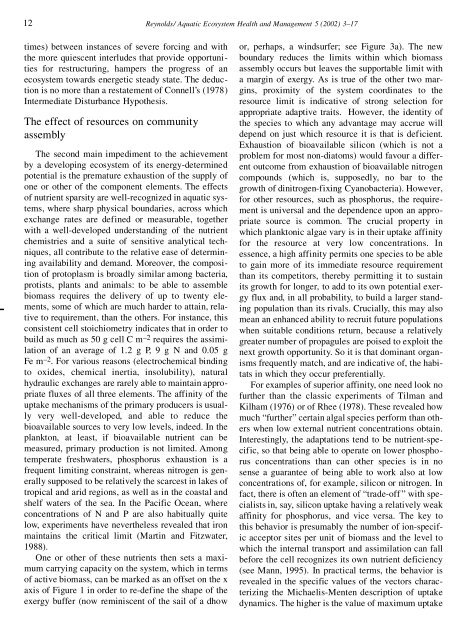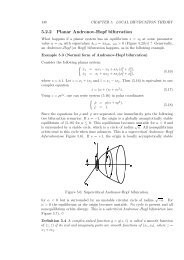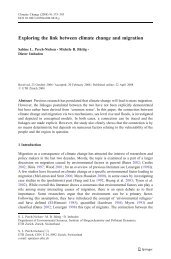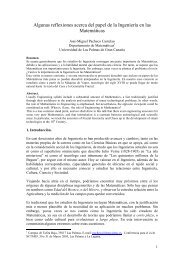Resilience in aquatic ecosystems - hysteresis, homeostasis, and ...
Resilience in aquatic ecosystems - hysteresis, homeostasis, and ...
Resilience in aquatic ecosystems - hysteresis, homeostasis, and ...
You also want an ePaper? Increase the reach of your titles
YUMPU automatically turns print PDFs into web optimized ePapers that Google loves.
12<br />
Reynolds/ Aquatic Ecosystem Health <strong>and</strong> Management 5 (2002) 3–17<br />
times) between <strong>in</strong>stances of severe forc<strong>in</strong>g <strong>and</strong> with<br />
the more quiescent <strong>in</strong>terludes that provide opportunities<br />
for restructur<strong>in</strong>g, hampers the progress of an<br />
ecosystem towards energetic steady state. The deduction<br />
is no more than a restatement of Connell’s (1978)<br />
Intermediate Disturbance Hypothesis.<br />
The effect of resources on community<br />
assembly<br />
The second ma<strong>in</strong> impediment to the achievement<br />
by a develop<strong>in</strong>g ecosystem of its energy-determ<strong>in</strong>ed<br />
potential is the premature exhaustion of the supply of<br />
one or other of the component elements. The effects<br />
of nutrient sparsity are well-recognized <strong>in</strong> <strong>aquatic</strong> systems,<br />
where sharp physical boundaries, across which<br />
exchange rates are def<strong>in</strong>ed or measurable, together<br />
with a well-developed underst<strong>and</strong><strong>in</strong>g of the nutrient<br />
chemistries <strong>and</strong> a suite of sensitive analytical techniques,<br />
all contribute to the relative ease of determ<strong>in</strong><strong>in</strong>g<br />
availability <strong>and</strong> dem<strong>and</strong>. Moreover, the composition<br />
of protoplasm is broadly similar among bacteria,<br />
protists, plants <strong>and</strong> animals: to be able to assemble<br />
biomass requires the delivery of up to twenty elements,<br />
some of which are much harder to atta<strong>in</strong>, relative<br />
to requirement, than the others. For <strong>in</strong>stance, this<br />
consistent cell stoichiometry <strong>in</strong>dicates that <strong>in</strong> order to<br />
build as much as 50 g cell C m –2 requires the assimilation<br />
of an average of 1.2 g P, 9 g N <strong>and</strong> 0.05 g<br />
Fe m –2 . For various reasons (electrochemical b<strong>in</strong>d<strong>in</strong>g<br />
to oxides, chemical <strong>in</strong>ertia, <strong>in</strong>solubility), natural<br />
hydraulic exchanges are rarely able to ma<strong>in</strong>ta<strong>in</strong> appropriate<br />
fluxes of all three elements. The aff<strong>in</strong>ity of the<br />
uptake mechanisms of the primary producers is usually<br />
very well-developed, <strong>and</strong> able to reduce the<br />
bioavailable sources to very low levels, <strong>in</strong>deed. In the<br />
plankton, at least, if bioavailable nutrient can be<br />
measured, primary production is not limited. Among<br />
temperate freshwaters, phosphorus exhaustion is a<br />
frequent limit<strong>in</strong>g constra<strong>in</strong>t, whereas nitrogen is generally<br />
supposed to be relatively the scarcest <strong>in</strong> lakes of<br />
tropical <strong>and</strong> arid regions, as well as <strong>in</strong> the coastal <strong>and</strong><br />
shelf waters of the sea. In the Pacific Ocean, where<br />
concentrations of N <strong>and</strong> P are also habitually quite<br />
low, experiments have nevertheless revealed that iron<br />
ma<strong>in</strong>ta<strong>in</strong>s the critical limit (Mart<strong>in</strong> <strong>and</strong> Fitzwater,<br />
1988).<br />
One or other of these nutrients then sets a maximum<br />
carry<strong>in</strong>g capacity on the system, which <strong>in</strong> terms<br />
of active biomass, can be marked as an offset on the x<br />
axis of Figure 1 <strong>in</strong> order to re-def<strong>in</strong>e the shape of the<br />
exergy buffer (now rem<strong>in</strong>iscent of the sail of a dhow<br />
or, perhaps, a w<strong>in</strong>dsurfer; see Figure 3a). The new<br />
boundary reduces the limits with<strong>in</strong> which biomass<br />
assembly occurs but leaves the supportable limit with<br />
a marg<strong>in</strong> of exergy. As is true of the other two marg<strong>in</strong>s,<br />
proximity of the system coord<strong>in</strong>ates to the<br />
resource limit is <strong>in</strong>dicative of strong selection for<br />
appropriate adaptive traits. However, the identity of<br />
the species to which any advantage may accrue will<br />
depend on just which resource it is that is deficient.<br />
Exhaustion of bioavailable silicon (which is not a<br />
problem for most non-diatoms) would favour a different<br />
outcome from exhaustion of bioavailable nitrogen<br />
compounds (which is, supposedly, no bar to the<br />
growth of d<strong>in</strong>itrogen-fix<strong>in</strong>g Cyanobacteria). However,<br />
for other resources, such as phosphorus, the requirement<br />
is universal <strong>and</strong> the dependence upon an appropriate<br />
source is common. The crucial property <strong>in</strong><br />
which planktonic algae vary is <strong>in</strong> their uptake aff<strong>in</strong>ity<br />
for the resource at very low concentrations. In<br />
essence, a high aff<strong>in</strong>ity permits one species to be able<br />
to ga<strong>in</strong> more of its immediate resource requirement<br />
than its competitors, thereby permitt<strong>in</strong>g it to susta<strong>in</strong><br />
its growth for longer, to add to its own potential exergy<br />
flux <strong>and</strong>, <strong>in</strong> all probability, to build a larger st<strong>and</strong><strong>in</strong>g<br />
population than its rivals. Crucially, this may also<br />
mean an enhanced ability to recruit future populations<br />
when suitable conditions return, because a relatively<br />
greater number of propagules are poised to exploit the<br />
next growth opportunity. So it is that dom<strong>in</strong>ant organisms<br />
frequently match, <strong>and</strong> are <strong>in</strong>dicative of, the habitats<br />
<strong>in</strong> which they occur preferentially.<br />
For examples of superior aff<strong>in</strong>ity, one need look no<br />
further than the classic experiments of Tilman <strong>and</strong><br />
Kilham (1976) or of Rhee (1978). These revealed how<br />
much “further” certa<strong>in</strong> algal species perform than others<br />
when low external nutrient concentrations obta<strong>in</strong>.<br />
Interest<strong>in</strong>gly, the adaptations tend to be nutrient-specific,<br />
so that be<strong>in</strong>g able to operate on lower phosphorus<br />
concentrations than can other species is <strong>in</strong> no<br />
sense a guarantee of be<strong>in</strong>g able to work also at low<br />
concentrations of, for example, silicon or nitrogen. In<br />
fact, there is often an element of “trade-off ” with specialists<br />
<strong>in</strong>, say, silicon uptake hav<strong>in</strong>g a relatively weak<br />
aff<strong>in</strong>ity for phosphorus, <strong>and</strong> vice versa. The key to<br />
this behavior is presumably the number of ion-specific<br />
acceptor sites per unit of biomass <strong>and</strong> the level to<br />
which the <strong>in</strong>ternal transport <strong>and</strong> assimilation can fall<br />
before the cell recognizes its own nutrient deficiency<br />
(see Mann, 1995). In practical terms, the behavior is<br />
revealed <strong>in</strong> the specific values of the vectors characteriz<strong>in</strong>g<br />
the Michaelis-Menten description of uptake<br />
dynamics. The higher is the value of maximum uptake






